|
|
Before Mao Tse-tung created today’s unified China under communist rule the country was a weak state ravaged by foreign powers, a weakness exemplified by Puyi, the last Emperor of China.
Anyone who has seen Bertolucci’s The Last Emperor (highly recommended if you haven’t) knows the basics: the strangely pampered childhood after his rise to the throne at two years of age, his mentoring by the Imperial household’s eunuchs, his weak government overthrown by the invading Japanese who made Puyi their puppet, and his forced “reformation” under the communists turning the last Emperor of China into an everyday citizen of the People’s Republic.
 Scene from the movie “The Last Emperor”  One major error in the movie is the central love interest centering around Puyi’s wife. According to many witnesses, Puyi was gay. Mocked from his youth for his feminine figure, his stereotypically awkward glasses, and his preference for men, Puyi’s homosexuality is openly discussed in modern China. His own sister-in-law wrote in her memoirs that he lived with a pageboys as his concubines, and many say he never consummated his marriage. One major error in the movie is the central love interest centering around Puyi’s wife. According to many witnesses, Puyi was gay. Mocked from his youth for his feminine figure, his stereotypically awkward glasses, and his preference for men, Puyi’s homosexuality is openly discussed in modern China. His own sister-in-law wrote in her memoirs that he lived with a pageboys as his concubines, and many say he never consummated his marriage.
While traditional China accepted homosexuality as a normal aspect of the human condition, people in Puyi’s time said he and his wife Gobulo Wan Rong could not have children because he was infertile, a common way of talking around homosexuality. There is even a later story of the estranged Empress getting pregnant by her chauffeur, the baby killed at birth.
I find Puyi fascinating as a gentle man born into a central role in a tragic history. I cannot imagine what his life was like, but I can imagine the quiet life he might have led if born into more normal circumstances. His surviving relatives gathered recently for a touching discussion of their famous relation. A niece says he was such a playful man that, “he was just like one of the kids,” and so humble the other children who knew him did not believe he had ever been the Emperor. They laughed about how this man, raised in such mind-bending privilege, could not even use money correctly for everyday transactions.
Some tender souls are born into ill-fitting circumstances. It is strange to think of the cosmic karma that created a life as extravagantly odd as Puyi’s. My empathy goes out to anyone who struggles to fit into life wherever their birth takes them.


An homage to my home planet.
If you haven’t seen any of these videos taken from the International Space Station, they are beyond beautiful.
…and two more after the jump…
Continue reading Earth From Space →
 I know the author Fran Lebowitz mostly because she is so quotable. In a recent article she nailed what I have felt for a long time — that much of the progress we have made as a gay community is because of AIDS. That most massive of dark clouds had an astonishing silver lining. It forced us out of the closet. I know the author Fran Lebowitz mostly because she is so quotable. In a recent article she nailed what I have felt for a long time — that much of the progress we have made as a gay community is because of AIDS. That most massive of dark clouds had an astonishing silver lining. It forced us out of the closet.
As Lebowitz said in a recent interview in The Awl:
The idea—and not just the idea, the actual life of homosexuals—changed immeasurably because of the acceptance of homosexuality. And that was because of AIDS. No one ever says that. Or how AIDS caused gay marriage. I mean, it would never have existed. You could pretend to your family that you were straight, but you couldn’t pretend you weren’t dying.
As AIDS forced our entire community out of hiding, it also pressured my generation into pretending we were normal. Even if we had HIV, even if we were dying, most of us did not want to be associated with this disease the culture so deeply feared. As Lebowitz tartly puts it:
And after AIDS, I think that [homosexual] people were afraid of a kind of official response to AIDS, like they would be arrested, or put in jail, all these kind of things, which are not unlikely things, by the way, and so they made up a lie. ‘We’re just like you. We are just like you, we’re exactly like you.’ But of course, they were not exactly like straight people. They were nothing like straight people.
Only now, after being outed by AIDS and overcoming the stigma of being gay and possibly diseased, are we coming into our own as people. That is the current gay politics: to be accepted as people, unique in our own rights and equal as citizens.
Sesame Street’s beloved Big Bird was created by two gay lovers who lived together for over 50 years, Kermit Love and his partner Christopher Lyall. They created the original Big Bird from a Jim Henson sketch and those glass toy drinking birds that rock back and forth as they drip their beaks in a glass of water.
Lyall and Love were partners in work and life for half a century and in the 1980s traveled with Big Bird to the White House for the annual Easter egg roll. The most momentous results of that presidential nexus were the grass stains on Big Bird’s outsize feet. Nobody could have imagined that this puppet might someday play even the smallest role in deciding who would occupy the Oval Office. “We’ll see,” Lyall says. The possible political impact of this 8-foot-2 yellow plumed character takes a turn from the ridiculous to the delightfully apt when you consider this: Big Bird was the product of a profound partnership between two men that was in every way a marriage save for in the strictly legal sense that the law until very recently forbade.
 Big Bird, left, and his creator Kermit Love, right. I think they both look like adorable muppets. Read the full story in The Daily Beast, its lovely about both the bird and his dads.
And hard as it is to believe, this lovely gay man who so influenced Sesame Street was actually named Kermit Love. According to Wikipedia at least, he was born Kermit Ernest Hollingshead Love. So. Cool.
Q.: Why do we call heterosexual people “straight”?
A.: Because homosexuality was a crime and “straight people” were those who did not commit that crime.
Saint Matthew teed off the concept with his description of the path to righteousness in Matthew 7:14, which King Jame’s translators rendered as:
Because strait is the gate, and narrow is the way, which leadeth unto life, and few there be that find it.
English speakers have said rule abiders follow the “straight and narrow” ever since. Dude gets out of prison and we tell him he should “go straight” and people who don’t do drugs are “straight.” Someone who is not straight is bent, a word we used for criminals, as well as homosexuals and any sexuality that did not have mainstream approval, back when those where overlapping categories.
 The intersection in front of my house is one way. ahem. Straight people are those who follow the rules, and are therefore not homosexual. It does makes me wonder if that word “straight” still works for heterosexuality.
And this all reminds me of a joke. When gay guys in a car come to an intersection we can’t really instruct the driver to “go straight,” so we have a substitute of our own …instructing the driver he should proceed “gaily forward.” Every little sub-culture has its own awkward humor. ;-)
 Malala Yousafzai, 14, was shot in the head for being a girl who wanted to go to school in her home city of Mingora, Pakistan. Taliban militants claimed responsibility after targeting her for openly expressing the belief that females should receive an education. After extensive brain surgery she is still alive, but barely. Malala Yousafzai, 14, was shot in the head for being a girl who wanted to go to school in her home city of Mingora, Pakistan. Taliban militants claimed responsibility after targeting her for openly expressing the belief that females should receive an education. After extensive brain surgery she is still alive, but barely.
There are cultures that fear women and the feminine wherever it appears. Control over women and suppression of the feminine become their core values.
Unsurprisingly, these are the same cultures that most fear the feminine aspect in men. Gay men, transexuals, and people born intersex are all anathema to these cultures, to be suppressed and wiped out when possible.
Healthy nature is a balance, an interplay, and a dance of the male-female and the masculine-feminine. Islamic extremists do us all a favor when they highlight the dangers of suppressing women and the feminine, but the rest of us should not be too smug. This same bias is built into too many of our cultures and religions.
Malala Yousafzai’s desire to go to school, and the violent reaction it spurred, should be a wake up call for all of us. We must embrace all of God’s children, respecting and celebrating the things that make us the same and the things that make each one of so unique, in women and men.
The BBC has more on the brave actions of Malala Yousafzai. May she, and all women under such oppression, live into a better future.
From the travel website Expedia, one of the many companies in Washington State that have stood up for marriage equality for their employees and customers, comes this lovely story:
Most parents of gay kids have a similar story of their journey to acceptance.
I love the backstory Expedia shares:
Nikki and Jill had first met as young girls at overnight camp. Twenty-five years later, the two reunited on the camp’s website, and rekindled the connection they knew as childhood friends. That friendship blossomed into attraction and became the foundation of a loving adult partnership.
The name of the god Apollo rings across time as the classic young, powerful, beautiful man. He is typically portrayed as the ideal kouros, the beardless athletically bodied youth idealized by the ancient Greeks. Apollo had many powerful attributes as he was the god of the sun and light, prophecy, healing, music, and poetry. Typical of handsome young men, he was also known for his sexy ways.
At one point Apollo fell in love with a young man named Hyacinth. One day they were playing discuss together as Zephyr, the god of the west wind, watched. Zephyr grew jealous of their affections and when Apollo threw the discuss high into the air Zephyr blew the discuss back at Hyacinths head, killing him.
As Hyacinth’s head hung broken from his body, drooping like a flower blossom from its stalk, his blood spilled into the earth. On that spot a beautiful flower sprang up, the Hyacinth, although it was probably the flower we now call the Iris.
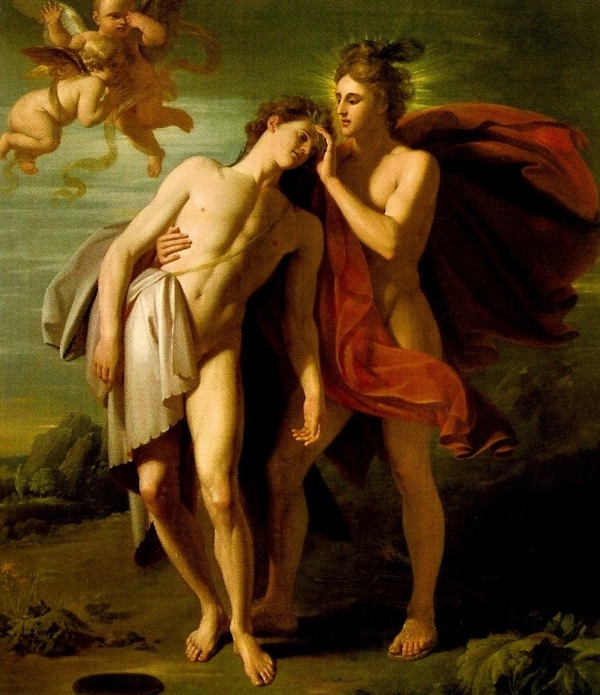 The Death of Hyacinth by Benjamin West, 1771, Swathmore College, Philadelphia.
For more ancient myths that include gay people and gender variation, click here.
Pompeii is important because it froze a Roman city in time, so we get to see glimpses of ancient lives caught in their doomed city like a fly in amber.
One of the fascinating things preserved in Pompeii is the graffiti on the city walls where the thoughts of the people are written uncensored by subsequent history, and what we learn is that not much has changed. The walls of Pompeii read like a truck stop bathroom, including some colorful gay comments. As they appeared on August 24, 79 AD:
On the bar-brothel of Innulus and Papilio: Weep, you girls. My penis has given you up. Now it penetrates men’s behinds. Goodbye, wondrous femininity!
On the house of the Citharist below a drawing of a man with a large nose: Amplicatus, I know that Icarus is buggering you. Salvius wrote this.
On the basilica: Phileros is a eunuch!
On the Eumachia Building: Secundus likes to screw boys.
On the house of Orpheus: I have buggered men.
And who knows who wrote this one, male or female?
On the house of Poppaeus Sabinus: If you felt the fires of love, mule-driver, you would make more haste to see Venus. I love a charming boy; I ask you, goad the mules; let’s go. Take me to Pompeii, where love is sweet. You are mine…
Of course Pompeii wasn’t all gay. Most of the graffitti is straight, like these from the walls of a brothel where we get bragging men and a client’s review:
Celadus the Thracier makes the girls moan!
Gaius Valerius Venustus, soldier of the 1st praetorian cohort, in the century of Rufus, screwer of women
Myrtis, you do great blow jobs.
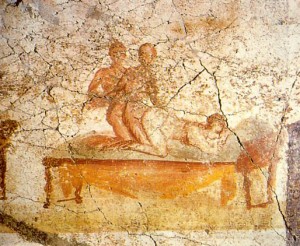 Two men and a woman having sex, from the Suburban Baths of Pompeii circa 79 BC. We find similar scenarios in the art of the Suburban Baths. A frieze there shows sixteen sex scenes, including male-male and female-female couples along with same-sex pairings within group sex scenes. Both men and women went to the bathe there, sharing a singular changing room, and we therefore presume these type of images where common and acceptable to the people of the day.
There is a simple question the anti-gay ask: If a gene creates a homosexual orientation that decreases human reproduction. Wouldn’t evolution weed out this unproductive gene?
Logical as that question seems, the answer is not that hard if we remember the obvious fact that each one of us adds more to humanity’s success than just our ability to reproduce. Women contribute more than the fruit of their wombs, and men contribute more than their sperm. To think otherwise is daft. Put even more simply, the overal survival of humanity is predicated on more than just our birthrate.
 To provide the simplest example, it is not the number of babies that determines reproductive success in a species, it is the number of children who successfully make it to adulthood and are able to have children of their own. Any trait that benefits the net success of reproductively viable adults should thrive. To provide the simplest example, it is not the number of babies that determines reproductive success in a species, it is the number of children who successfully make it to adulthood and are able to have children of their own. Any trait that benefits the net success of reproductively viable adults should thrive.
More specifically, genetic scientists Gavrilets and Rice found three possible reasons for the persistence of a genetic origin for homosexuality:
Answer #1: Overdominance
Overdominance says that if there is a gay gene, having two parents with that gene may make a child gay and decrease their reproduction, while getting the same gene from only one parent may increases that child’s reproductive success, resulting in increased reproduction over time.
We know this dynamic from Sickle Cell Anemia, where the gene from one parent makes you immune to malaria, but the gene from two parents gives you a crippling disease. A gene for homosexuality might work the same way.
Answer #2: Sexually antagonistic selection
This theory says that the same gene has different effects depending on the child’s gender. The gene that makes a brother gay and less sexually reproductive, may make his sister more reproductively successful, for a net increase.
The sexually antagonistic selection theory gains added credence when we note the sisters of gay men do, in fact, have more children than women who do not have gay brothers. The gay gene, or more likely, combination of genes, appears to be a net positive for the family.
There is also increasing evidence that male homosexuality may be have stronger genetic origins
Answer #3: Kin altruism
I personally like this one, as kin altruism posits that a gay gene may run in families, and the presence of a gay family member helps the overall reproductive fitness of the family, so the gene perpetuates.
This one is the most obviously logical, without the genetic complexities of the previous two. Clearly having a few confirmed bachelor uncles and spinster aunts around can be a helpful for large families, especially in stressful times. A related theory from the social sciences says that families benefit from having a certain percentage of spare adults around who are not tied to specific children.
Hard for us to imagine in our times when family means nuclear family, but families used to be large and complex social systems of interrelated people that benefited from a certain amount of diversity as they worked together for the common good.
Source:
- S. Gavrilets and W.R. Rice, Genetic models of homosexuality: generating testable predictions, Proc. R. Soc. Lond. B Biol. Sci. 273 (2006), pp. 3031–3038.
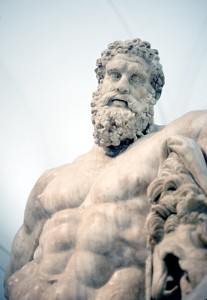 Farnese Hercules statue, Roman copy of a Greek original circa 300 BC, National Archaeological Museum, Naples, Italy. The name Hercules (Heracles in Rome) still resonates as the ultimate slab of masculinity.
Hercules was a stud, having sex with countless women and bearing as many as 500 children. In one story a king named Thespios had Hercules help him get rid of a dangerous lion. Thespios also introduced Hercules to his family, which included 50 virgins. Nine months later 49 of them gave birth to sons, as the 50th was too shy.
Based on those stories, Hercules was clearly not “gay” in the modern political sense, yet Plutarch says he also had male lovers beyond counting. Names we know include his lovers Admetos, Iphitos, Euphemos, Elacatas, Abderus, and Iolaos.
In the most famous story of Hercules’ love for young men, he fell in love with Hylas during Jason’s quest for the golden fleece. As the poet Theocritus wrote in 300 BC, Hylas had locks of hair that hung down in curls,
And like a father with a dear son he taught him all the things which had made him a mighty man, and famous.
And they were inseparable, being together both day and night. That way the boy might grow the way he wanted him to, and being by his side attain the true measure of a man.
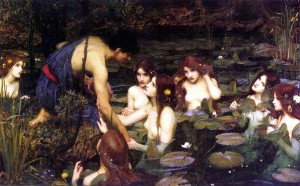 Hylas and the Nymphs, by John William Waterhouse Hercules helped row the ship Argo, but was so strong he broke the oar. When they got to land Hercules went to find a strong tree to make a new oar while Hylas went to a famous spring for water. At the spring Hyllus met nymphs who fell in love with his beauty and captured him, possibly dragging him into the water. Hercules was so distraught he remained there searching for Hylas when the Argos sailed, abandoning the expedition for love.
We know Hercules best for his famous labors, performed to please King Eurystheus. It was rumored Eurystheus was another of his lovers, providing the motivation for his heroic acts.
Hercules may not have been gay in the modern sense, but his love of men proved pivotal in his heroic life. Only by understanding all of who he was can we make sense of this heroic figure.
For more ancient myths that include gay people and gender variation, click here.
 Having grown up in a community defined by its sense of being persecuted for being different, primarily on the issue of marriage, it is painful to watch the inability of the Mormons to get the irony of their anti-marriage positions. Having grown up in a community defined by its sense of being persecuted for being different, primarily on the issue of marriage, it is painful to watch the inability of the Mormons to get the irony of their anti-marriage positions.
My theory on why Mormons, of all people, cling to the narrowest definitions of traditional marriage here.
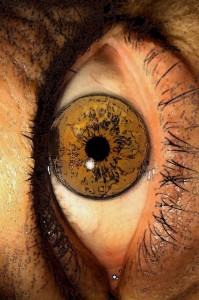 Adding to the physiological evidence that sexuality is hard wired comes a lovely study showing how our bodies respond to erotic images. Adding to the physiological evidence that sexuality is hard wired comes a lovely study showing how our bodies respond to erotic images.
In the past these studies measured genital arousal, an invasive procedure not everyone would want to submit to. It caused particular problems measuring the sexual response of those too young, old, or conservative to submit to typical sex research.
The new test is simpler and less invasive. Scientists show subjects erotic videos, and measure how their pupils dilate in response.
Some of the findings confirm the expected. Straight men’s pupils responded to sexual images of women, and barely responded to images of men. Straight women’s pupils responded to both, confirming Lisa Diamond’s theory that women’s sexuality is more fluid than men’s.
The most interesting finding was confirmation of the existence of male bisexuality. Contrary to previous physiological studies, bisexual men in this study had pupil dilation in response to both male and female images.
According to our pupillary responses, bisexuality exists.
Summary:
- Straight Women: Pupil dilations in response to both erotic male and female images.
- Gay Women: Pupil dilations in response to erotic female images.
- Straight Men: Pupil dilations in response to erotic female images.
- Gay Men: Pupil dilations in response to erotic male images.
- Bisexual Men: Pupil dilations in response to both erotic male and female images.
Source:
- Rieger G, Savin-Williams RC (2012) The Eyes Have It: Sex and Sexual Orientation Differences in Pupil Dilation Patterns. PLoS ONE 7(8): e40256. doi:10.1371/journal.pone.0040256
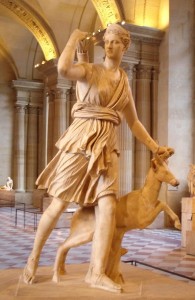 Diana of Versailles, attributed to Leochares, Roman circa 100 AD, Louvre Museum Artemis, called Diana by the Romans, was one of the greatest deities of Greece and Rome. She represented represented female power living as a maiden hunter with no need for a man.
Artemis (Diana) never married, living as a sworn virgin in the woods where they where they hunted and danced together. These nymphs also showed lovingly care for Artemis’ body, undressing her, bathing her, and expressing other intimacies together.
Depictions of Artemis (Diana) often portray the story of her affection for the nymph Callisto. As Ovid told the story, Artemis loved Callisto, but so did Zeus (Jupiter). So given that Callisto was also a sworn virgin, Zeus disguised himself as Artemis to get in close and seduce Callisto, and then raped her. Callisto got pregnant by Zeus and had a son, who then challenged his mother. To prevent catastrophe, Zeus then put mother and son in the sky as the constellations Ursa Major and Ursa Minor, the Big and Little Dippers.
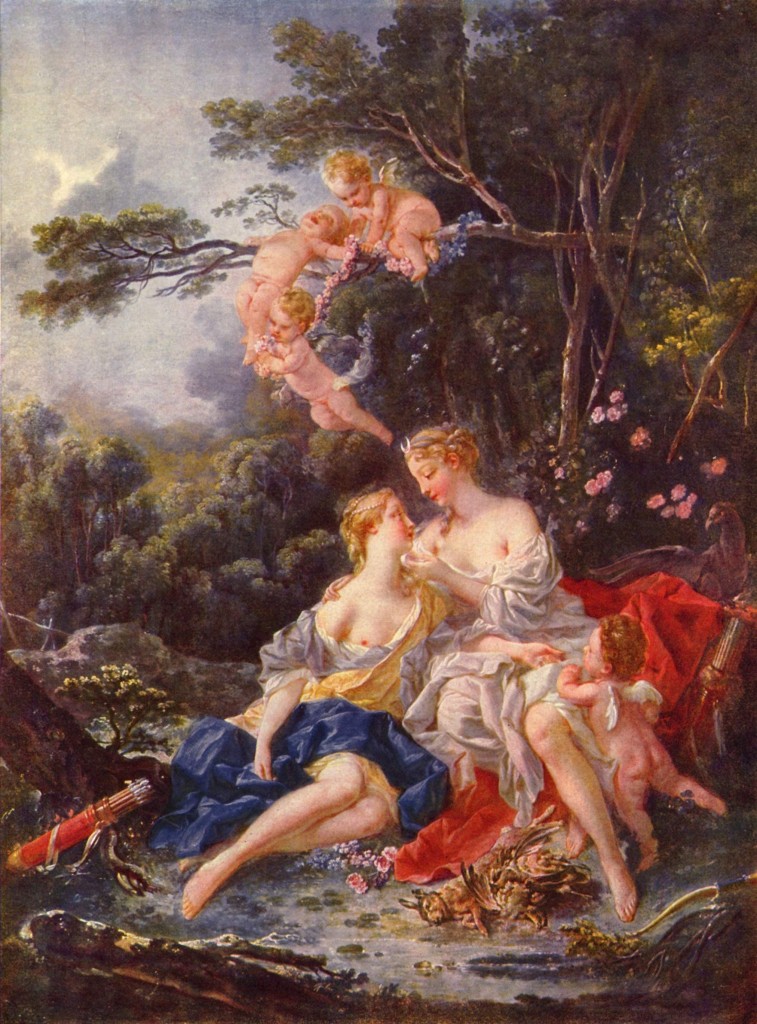
For more ancient myths that include gay people and gender variation, click here.
 (photo by Leland Bobbe, www.lelandbobbe.com) Drag queens are a bit of a mystery to me. I enjoy their color, bravado, and theatricality, but I’ve always wondered about the deeper feelings inside these men that drives them to such extreme, and often odd, semi-impersonations of woman.
Something in this photo essay by Leland Bobbe cracks open the mystery a bit. Drag queens are pictured half done up, half their natural male selves. More on the story behind the photos here.
 (photo by Leland Bobbe) Exposed as both person and persona, the stunning thing in these photos is the eyes. Exposing both sides of who they are in the same photo, these men lay exposed, their eyes the open windows to some very deep souls.
And therein lies my answer, I suppose. We all work to integrate all of who we are into one being and one life. In these faces I see people going to great lengths to express all of who they are, dichotomous as their presentation may seem. And for that work, and their sharing it with the rest of us, I am deeply grateful. Stunning.
Of course the most famous and heart wrenching portrayal of drag culture remains the 1990 documentary, “Paris Is Burning,” viewable here. If you’ve never seen it, put it on your list. It is an astonishing glimpse of another very different and very fabulous world where all the shiny outsides break open and reveals humanity’s heartbreaking depth.
 (photo by Leland Bobbe, www.lelandbobbe.com)
There is way more variety in life than we typically imagine. For one very odd example, the Tasmanian Echidna has a four-headed penis.
God certainly does delight in diversity.
 (click to embiggen, if you dare)
Sage advice for do-gooders everywhere…
Don’t ask yourself what the world needs;
ask yourself what makes you come alive.
And then go and do that.
Because what the world needs
is people who have come alive.
~ Howard Thurman

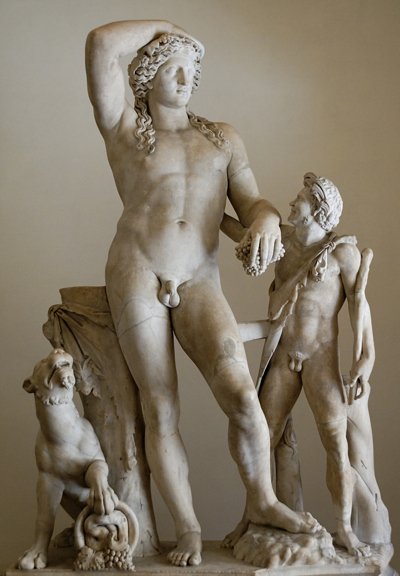 Dionysus and satyr, Roman copy of a Greek statue circa 200 AD, from the excavations of the Palazzo Mattei a Quattro Fontane. Dionysus and satyr, Roman copy of a Greek statue circa 200 AD, from the excavations of the Palazzo Mattei a Quattro Fontane.[/caption]Dionysus was the god of wine, ecstasy, poetry, and love.
He was often described as womanly and he was lovers to both Adonis, the male god of beauty and desire, and the two-sexed Hermaphrodite.
In Rome he was transformed into Bacchus, god of drunkenness and orgies, an older and less sensitive character.
For more ancient myths that include gay people and gender variation, click here.
There is a tidy little website lays out the basics of what we know about homophobia: CureHomophobia.org.
I love how cleanly it lays out the issues, including gems like this one:
Completely straight people
do not lie awake
worrying about the gay menace.
And this absolutely spot on graphic:
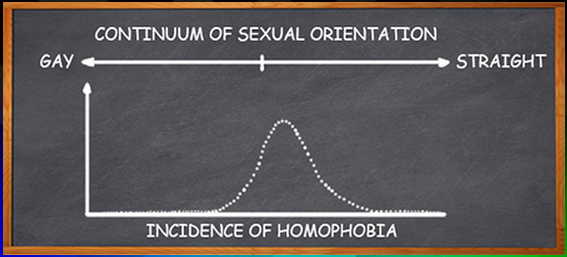
Homophobia is tough. But together, we can search for a cure.
Shy, he stepped off into the cornfield. I could see
his back muscles under the damp shirt quiver and go slack.
Turning again to face the shade, he smiled at me, not
squinted, smiled, and finished tugging shut his fly.
Now, when the cornstalks in the night wind slide
like fire, I see him. He steps closer in my dream.
I don’t know, where he sleeps, if sleep refreshes him,
but here it works me like hot metal over a flame.
From the poem “The Idea Of Beauty” by Meleagros, 3rd century, translated by Brooks Haxton in The Atlantic.

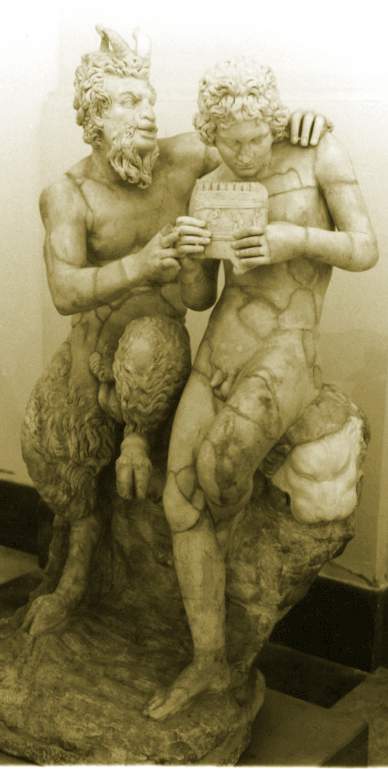 Pan teaching Daphnis to play the flute, Roman copy of a Greek original circa 100 BC, Naples Museum of Archeology. Pan (Faunus in Rome) was the half-man, half-goat god of music and nature. He lived in Arcadia and chased after women and men with his erect penis.
Not only did the half-goat Pan like sex with sheep, he also had a particular fondness for shepherds, which makes a lot of sense if you think about it.
The correlation between the goat-god Pan and our depictions of Satan with horns and hooves only dates back to the Victorian era when Neopaganism made that image popular. Earlier imaginations of Satan gave him claws, horns, and wings, not at all like playful Pan.
As the god of music Pan also gave us the panflute, or panpipes. In the image to right he is teaching Daphnis to play.
For more ancient myths that include gay people and gender variation, click here.
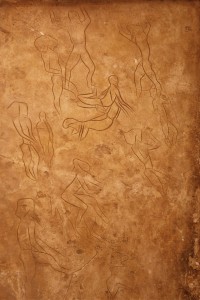 Replica of the paleolithical drawings in the cave of Addaura from the Museo Regionale Archeologico in Palermo. (Photographer: Bernhard J. Scheuvens aka Bis) One of the oldest depictions of sex we have ever found is a piece of homoerotic art. Carved into a Sicilian cave wall 120 centuries ago (!), the drawings of the Addaura cave depict men in bird masks with genitals displayed dancing in a circle. In the center of the circle two men with erections are poised one over the other, the erect penis of the male above connected by parallel lines with the buttocks of the man below. It is comical to read the tourist descriptions of these drawings as acrobatics, as if the men of 10,000 BC went deep into caves, pulled out their erections, and did cartwheels together. A more likely explanation came from the cave’s discoverer who described them as possible depiction of homoerotic initiation rituals, a likely possibility from a time when sexuality and the sacred where still merged.
If the caves of Addaura point to same-sex sexuality, the recent discovery of a male skeleton of a buried as a woman points to ancient gender variations. Five thousand years ago, a tribe of Stone Age humans lived near what is now Prague. We know little about them other than what we glean from their burial customs. Men were buried on their right sides with their heads facing east along with their weapons, flint knives, and tools like hammers. Women were buried with their heads facing west with their necklaces made from teeth, pets, copper earrings, and distinctive egg shaped jars. In 2011 scientists dug up a male skeleton buried in the female position without weapons but with household jugs and the egg shaped jar at his feet. There is no way to know how this man lived his life, if he was gay and loved men or transexual and lived his life as a woman. All we do know is that when he died his people gave him a respectful and traditional burial, as a woman.
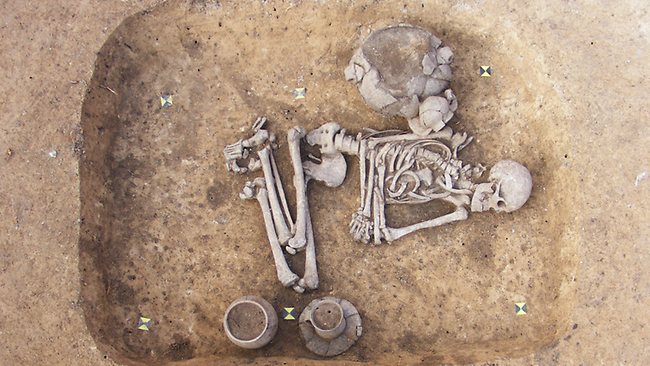 Early gay man from around 2900-2500 B.C., found outside Prague.
To hold the apparent paradox between science and religion* in a meaningful way, I propose a modern metaphor, the wave-particle duality of light. Einstein proved that light is the constant in the universe, and time is a variable, or as J.S. Bell said it, “In the realm of light there is no time.” Clearly light is a fundamental concept in the universe.
My favorite scripture is God’s declaration at the beginning of creation, “Fiat Lux,” or let there be light. For a long time we debated what exactly light was. In the 1600s, Isaac Newton said that light was a particle, while Christiaan Huygens argued that it was a wave. With modern science we discovered a new the answer: it is both. If we measure where light is at an exact time and place we see a particle. If we measure the pattern of light over time we see a wave. The wave-particle duality is equally true of the atoms of your desk, the snot in your nose, and the air we breathe. It appears that everything in the universe is both a wave and a particle at the same time, the difference lies in how we perceive it.
Arguing over the perspectives of science and religion is like arguing over waves and particles. Yes it is one and yes it is the other. Yes we can view existence through the lens of science and discover its marvels, and yes we can embrace soulful explanations for life and its meaning that exist outside of our ability to measurement. One does not invalidate the other, just as waves do not invalidate particles. To argue from only one perspective, truth is in science or truth is in spirit, is to endless prove your own argument but ultimately miss the truth.
 Pacifica Ridge from Brooks Falls Trail * I know it is out of fashion with the smart set, but I believe religion is essential. We need culture, symbols, rituals, and stories that explain how our individual lives in our vast and confusing universe. Most importantly, we need a relationship with the essence of the universe that is so much bigger than ourselves. Sadly, concepts like religion, God, and spirit have been co-opted by the haters. We cannot let their pinched minds rob the rest of us of some most useful concepts, vocabulary, and beliefs. The divine glow of the universe is way too beautiful and important. We must all celebrate it in whatever way that makes our hearts sing.
Mighty Zeus (Roman Jupiter) was the greatest of all, the father of gods and men, a status he achieved by having a lot of sex with a lot of different women, both divine and mortal.
Zeus also fell madly in love with Ganymede, prince of Troy and a young man commonly described as the most beautiful of mortals. Zeus abducted Ganymede, took him to Mount Olympus, and granted him eternal youth. The Greeks saw love of Zeus for Ganymede was seen as the enduring archetype for older-younger male relationships.
All the gods loved Ganymede except Zeus’s consort Hera who was jealous of this beautiful young man’s rivalry for Zeus’s affections, so she put Ganymede in the sky where we now see him as the constellation Aquarius. Ganymede was later seen as the source of the fountains of the Nile, the divinity pouring out the life-giving water supply.
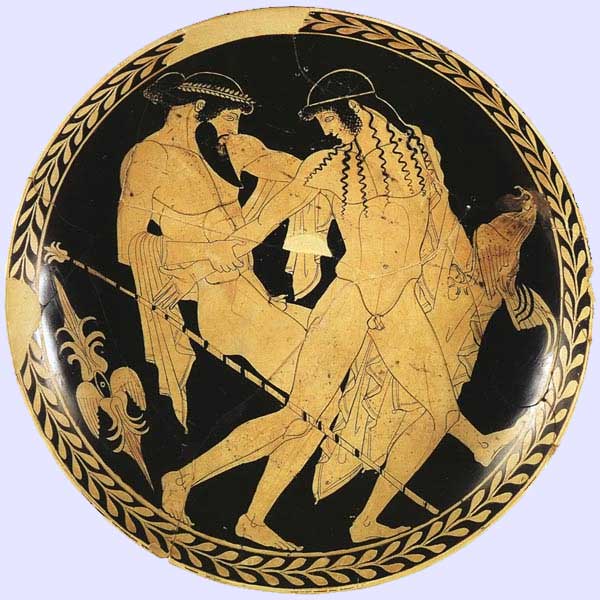 The Abduction of Ganymede. The great god Zeus and young Ganymede holding a cock in his hand, a love gift from Zeus. 450 BC, from the Museo Archeologico Nazionale, Ferrara, Italy.
For more ancient myths that include gay people and gender variation, click here.
If you haven’t seen this, it really is touching and a powerful mood reset, if you need one. Plus it gives a great sense of the spirit of Burning Man.
Mark Twain asked:
But who prays for Satan?
Who, in eighteen centuries,
has had the common humanity to pray
for the one sinner that needed it most?
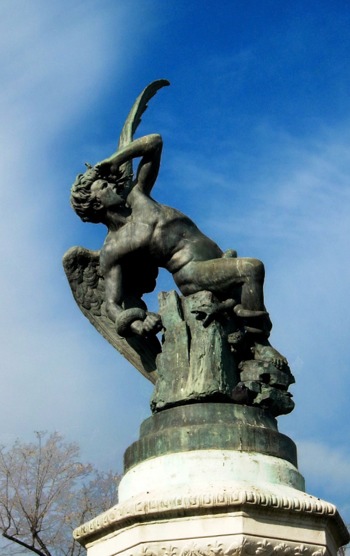 Lucifer falling from Heaven by Ricardo Bellver (Daniel Coomber/Flickr)
 On the 100th anniversary of the sinking of RMS Titanic, it is worth remembering that there were plenty of gay people on board that frightful night. On the 100th anniversary of the sinking of RMS Titanic, it is worth remembering that there were plenty of gay people on board that frightful night.
With passengers and crew of 2,223 people, and using the standard current guess of 4% gay, that would mean 89 gay men and women on board. However, knowing homosexuality was common in both marine and travel industries (just as they are today – see: Ships, Cruise) we can guess the numbers below decks where significantly higher than that 4% figure.
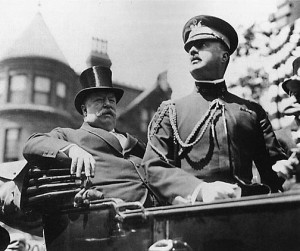 Archie Butt (right) and President Howard Taft There were certainly gay people among the gentry as well. Historians have looked most carefully at one pair of passengers, Archie Butt, an aide to President Howard Taft, and Frank Millet, a painter. After sharing a stateroom together in Berlin they traveled in separate berths on the doomed ship. Butt was a lifelong bachelor who courted rumors of interests in women but declared he would not marry. He was close to his mother, loved his flashy uniforms which he kept in top shape at all times, and took seven steamer trunks along with him for his six week trip to Europe. (Ahem.) Millet was older than Butt, and well known to be gay. He was married but lived apart from his wife. Millet was the man who convinced Butt to join him on the trip to Europe.
While people of that time didn’t spoke openly of homosexuality, the relationship between Butt and Millet was so well known their friends erected a fountain in the pair’s honor in Washington, DC after their deaths. As the Secretary of the American Civic Association, Richard Walrous, said in the New York Times of the April 17, 1912:
“No Damon and Pythias* friendship could have been closer than the friendship of Major Butt and Millet,” said Mr. Watrous. “The two kept quarters together and were inseparable when both were in Washington. They lived near the Metropolitan Club, Butt being, as is well known, a bachelor, and Mr. Millet’s family being quartered at his home in England… Among all of us who knew of the close friendship of Major Butt and Mr. Millet there has been the tensest of feeling since the news of disaster to the Titanic reached us.”
* Damon and Pythias were used as a code for gay relationships as they where two male mythical figures who demonstrated their undying love for each other.
[Update, July 2012]
I recently dined with my buddy Kamran in the original dining room of the Titanic.
Kami and I were blessed with a cruise to Alaska with my family on the Celebrity Millenium. (Loved Alaska! Proof in our way-too-many pics here.) On top of being overstuffed daily, we booked a table one night in the ship’s upscale restaurant, the Olympic, a room originally built as the fancy dining room of the Titanic.
The Olympic was the sister ship of Titanic, and according to the story Celebrity tells the Olympic was finished first, so Cunard switched the names of the ships so the first shipped launched would be named Titanic. So this dining room was actually built to be the Titanic’s, but sailed with the moniker Olympic. After years of service the dining room paneling was dismantled and installed in a stately old English home, and then later sold off as a setting for fancy cruise ship dining.
Regardless. The food was unbelievable, the service impecable and fun, and we ate until we were bursting. Hard to imagine the Titanic’s passengers ate better, and if nothing else it makes for a great story. ;-)
 Here’s a crazy association: Apple’s famous but enigmatic logo, the apple with a bite out of it, has been tied to the suicide of a gay man. Here’s a crazy association: Apple’s famous but enigmatic logo, the apple with a bite out of it, has been tied to the suicide of a gay man.
We know Alan Turing as one of the greatest men of the 20th Century and inventor of the computer, but he was persecuted for the crime of homosexuality and finally committed suicide by eating an apple laced with cyanide.
Apple’s original log was an apple, and rainbow stripped, a common symbol of gay diversity. So did Steve Jobs choose an emblem that represented this brilliant but tragic story?
No. But the famously secretive Steve Jobs never denied it either, leaving the question of the origin of Apple’s apple open to all our projections, and making Apple all the more interesting for it.
Scientific America discusses why our brains love a good story, regardless of the truth.
 One of the most important people in the modern history was a gay man. He was the first person to conceptualize the “thinking machine” we now call a computer, and he was the single person most responsible for saving the world from the Nazis. Yet the story ends tragically. One of the most important people in the modern history was a gay man. He was the first person to conceptualize the “thinking machine” we now call a computer, and he was the single person most responsible for saving the world from the Nazis. Yet the story ends tragically.
In 1936, at twenty four, Alan Turing announced that, “It is possible to invent a single machine which can be used to compute any computable sequence.” Taking advantage of Turing’s brilliance, the Allies made him a key member of the secret code cracking team at Bletchley Park where he and his thinking machines cracked the Nazi Enigma code. From that point on the Allies could intercept commands sent to German U-boats in real time, turning the course of the war. Sir Harry Hinsley, a veteran of the Bletchley Park team and the official historian of British Intelligence in World War II said that Turing’s work shortened the war “by not less than two years and probably by four years.”
Sadly, saving the world was not enough to prove a gay life acceptable in his day. Turing was convicted by a court for being a homosexual in 1952, a felony. Publicly humiliated and chemically castrated, his career and life destroyed, he committed suicide in 1954 at the age of 41.
The brilliance of Alan Turing remains current through the Turing Test, a challenge he developed to determine if machines can think. While it is dauntingly difficult to define thinking, Turning’s test proposed a profoundly human interaction. An interrogator asks questions of two unseen subjects using a keyboard. One of the subjects is human and the other a computer. The test is passed if the interrogator cannot tell which is subject is the machine. No computer has yet passed the Turing Test.
Now that we can see gay people as human beings, the world is seeing Turing for the genius he truly was. In 2000, Alan Turing was named one of the 100 most important people of the 20th Century by Time Magazine. In 2009 the British Prime Minister offered an official governmental apology to Alan Turing noting, “We’re sorry, you deserved so much better.” The science journal Nature recently devoted an entire issue to Turing, and there is a petition currently circulating to put Turing on the UK ten-pound note.
Turing said that when we build intelligent machines we are not creating souls, but rather building the mansions for the souls God creates. While touring Google a few years ago, science historian George Dyson noted:
I walked around and saw what they were doing and realized they were building a very large distributed AI, much as Turing had predicted. And I thought, my God, this is not Turing’s mansion — this is Turing’s cathedral. Cathedrals were built over hundreds of years by thousands of nameless people, each one carving a little corner somewhere or adding one little stone. That’s how I feel about the whole computational universe. Everybody is putting these small stones in place, incrementally creating this cathedral that no one could even imagine doing on their own.
Turing would be 100 this year.

One of the most publicized indications of homosexuality written on the body turned out to be false, or at least ambiguous. Luckily science updates itself when the facts change.
Widely reported, the initial study found that gay men’s hair tends to swirl around the crown of their head one way, while straight men’s tends to swirl the other direction. Straight men won’t admit to swirling, but a glance at their crowns shows they do. The technical term is actually whorl, and researchers looked at gay and straight men’s whorls and noted their clockwise and counter-clockwise manifestations.
Subsequent studies have not validated the hair whorl findings, and scientists are not sure hair whorls are a valid feature to count. As one says after analyzing the situation:
It’s hard to determine which way the hair whorls in people with long or curly hair, and the data do not fit the simple genetic model perfectly. So you should not use hair whorl direction to demonstrate basic genetics.
He doesn’t even mention those of us who no longer swirl around our crowns. :-(
 They both tell us the same about our sexuality. Not much.
Source:
This article is part of a series, Written on the Body, exploring the correlations between our body structures and sexual attraction.
|
|

 One major error in the movie is the central love interest centering around Puyi’s wife. According to many witnesses, Puyi was gay. Mocked from his youth for his feminine figure, his stereotypically awkward glasses, and his preference for men, Puyi’s homosexuality is openly discussed in modern China. His own sister-in-law wrote in her memoirs that he lived with a pageboys as his concubines, and many say he never consummated his marriage.
One major error in the movie is the central love interest centering around Puyi’s wife. According to many witnesses, Puyi was gay. Mocked from his youth for his feminine figure, his stereotypically awkward glasses, and his preference for men, Puyi’s homosexuality is openly discussed in modern China. His own sister-in-law wrote in her memoirs that he lived with a pageboys as his concubines, and many say he never consummated his marriage.

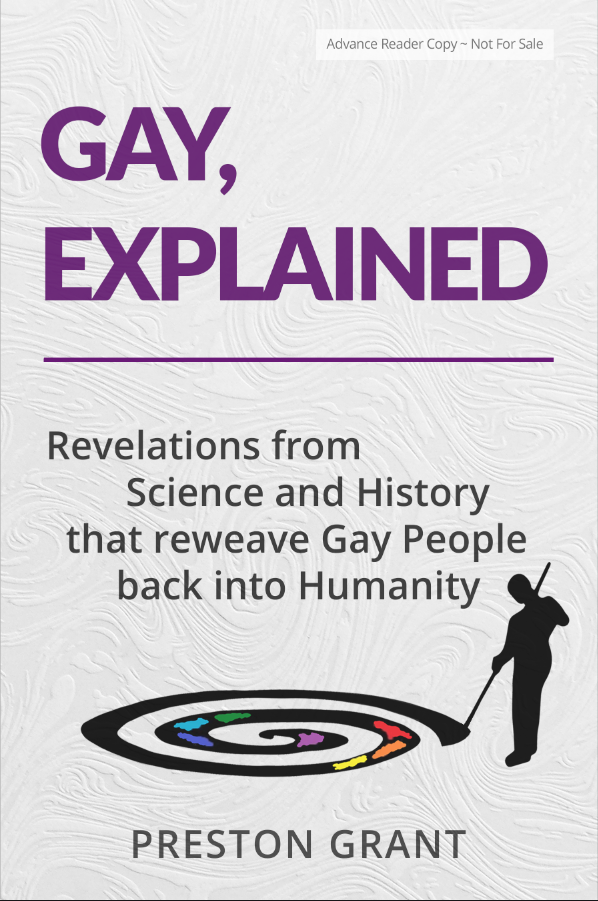

 I know the author Fran Lebowitz mostly because she is so quotable. In a recent article she nailed what I have felt for a long time — that much of the progress we have made as a gay community is because of AIDS. That most massive of dark clouds had an astonishing silver lining. It forced us out of the closet.
I know the author Fran Lebowitz mostly because she is so quotable. In a recent article she nailed what I have felt for a long time — that much of the progress we have made as a gay community is because of AIDS. That most massive of dark clouds had an astonishing silver lining. It forced us out of the closet. 

 Malala Yousafzai, 14, was shot in the head for being a girl who wanted to go to school in her home city of Mingora, Pakistan. Taliban militants claimed responsibility after targeting her for openly expressing the belief that females should receive an education. After extensive brain surgery she is still alive, but barely.
Malala Yousafzai, 14, was shot in the head for being a girl who wanted to go to school in her home city of Mingora, Pakistan. Taliban militants claimed responsibility after targeting her for openly expressing the belief that females should receive an education. After extensive brain surgery she is still alive, but barely. 

 To provide the simplest example, it is not the number of babies that determines reproductive success in a species, it is the number of children who successfully make it to adulthood and are able to have children of their own. Any trait that benefits the net success of reproductively viable adults should thrive.
To provide the simplest example, it is not the number of babies that determines reproductive success in a species, it is the number of children who successfully make it to adulthood and are able to have children of their own. Any trait that benefits the net success of reproductively viable adults should thrive.































